______________________________________________________________________________
Note: To make the text larger or smaller, do the following things: If you are right-handed, use the cursor in the following way:
- Holding the control button down, roll your cursor forward to make the text larger or roll your cursor backwards to make the text smaller.
___________________________________________________________________________
A Personal Note: Harriet (my wife) and I jointly share a spirit of adventure. As we have no mortgage, we are free to travel the world financially. We built a handmade house in 1981 on five acres of land 35 kms. out of Brisbane, Australia for minimal money.
See the house / land posts:
OUR HOUSE …. An Overview
OUR HOUSE ….The Actual Garden See the photos of the house and garden and the history of how we obtained rejected materials like from the Supreme Courthouse stone (where the Law Courts are now in Brisbane) …. two loads for nothing in 1980. They dumped 100’s of cubic metres as fill and built a school over the top. The stone was cut out of the Kangaroo Points Cliffs in 1877.
See these travel posts:
- Ken and Harriet’s Travel posts from 2003 to 2018. I wrote this in April 2020 even though this New Zealand Travel Blog May 2010.
- An International Perspective ….. Ken and Harriet’s Travel post from 2003 to 2018
_________________________________________________________________________
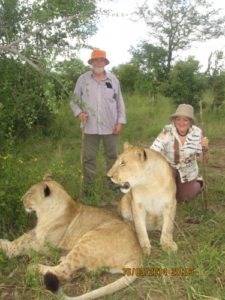
We walked with two lions and patted them
_____________________________________________________________________________
Our Overall Trip Details:
AFRICAN HOLIDAY with a week in PERTH (Australia) at Margaret River = 2nd – 8th March: Margaret River (We are also a member of Wyndham Vacation Resorts Asia Pacific (a holiday share organisation).
Then we flew a third of a world around to Madagascar finally.
- 9th March: Johannesburg
- 9th – 14th March: Hoedspruit …. Bogani Mountain Lodge
- 14th- – 17th March: Victoria Falls Safari Lodge
- 18th- March – 1st April: Madagascar
- 2nd April: Home to Brisbane via Johannesburg to Perth then to Brisbane
______________________________________________________________________
9th – 14th March: Hoedspruit …. Bogani Mountain Lodge
Bongani Mountain Lodge, Mthethomusha Game Reserve in Mpumalanga
How far do you have to travel to find peace and quiet and connect with the simple life? When it’s time to get back to the things that really matter – such as the tranquility of nature, the excitement of culture, and the fascination of history, take a trip to Bongani Mountain Lodge. This game reserve in Mpumalanga puts guests in the pulse of nature and luxury.
Bongani Mountain Lodge borders the southern side of The Kruger National Park and offers luxurious bush accommodation situated near the magnificent Malelane Mountains. Humbly located in the 8,000 hectare Mthetomusha Game Reserve, Bongani Lodge welcomes guests to a world of peace and calm. The game reserve in Mpumalanga is home to the “Big Five”, and an entertaining variety of birdlife. The lodge’s location alone inspires travellers from around the world.
This game reserve in Mpumalanga offers the ultimate luxury outdoor living space suitable for families, groups and even individuals. Everyone is invited to indulge in all that is available on offer. During Adventurous game drives and bush walks through the game reserve in Mpumalanga, guests may witness first hand more mammal species than in any other African Game Reserve.
This one of a kind accommodation near the Kruger Park also offers a fully equipped and air-conditioned conference venue, perfect for long and drawn out conferences. The game reserve in Mpumalanga, with all its magnificent views and peaceful nature, makes Bongani Lodge the perfect setting for a wedding venue. Small, intimate weddings at this exquisite accommodation offer a unique and special twist of romance and love.
___________________________________________________________________________________________________________
Bongani …. Mountain Lodge set in amongst these Granite Outcrops
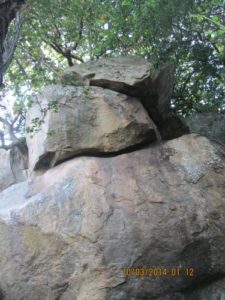
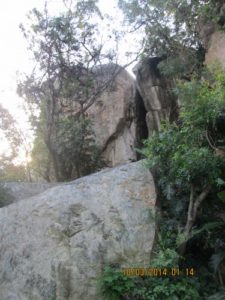
You enter the main building for meals or meeting other people past huge granite boulders like these

The Bongani sign on the wall of the main lodge
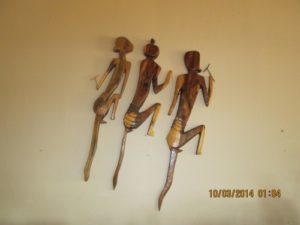
Bongani …. the Main Central Lodge for Eating and Meeting People.
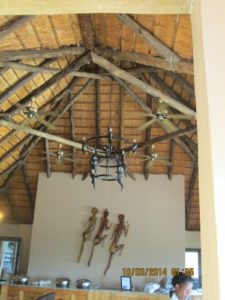
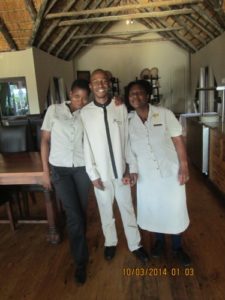
The cooking staff for breakfast, lunch and dinner ….. they produced wonderful meals
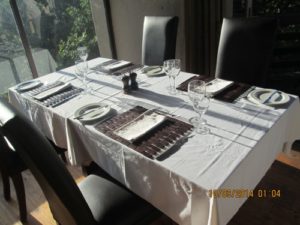
_______________________________________________________________________________________________________
Bongani …. Units for Living
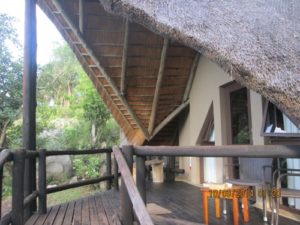
This was our unit for a week. Rooms make use of natural materials, including stone, timber and thatch, with a natural palette of taupe, browns and greys, resulting in a peaceful yet modern environment.
We were informed not go walking down to our unit at night but to go with a security guard using a torch. We could meet a wild animal.

Our unit had a nice shower and vanity basin and a comprehensive mosquito net to prevent you from being bitten by malaria bearing mosquitoes. We did get anti – malaria treatment before left Brisbane, Australia.
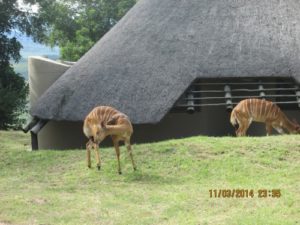
Bushbuck or Kudu = Antelope. These animals are called ‘Bush McDonalds’ …. they multiply so fast ! These would be feeding on the grass outside our unit in the middle of the day.
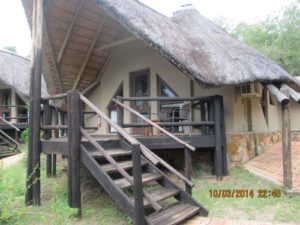
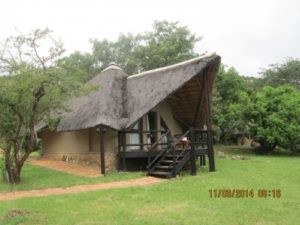
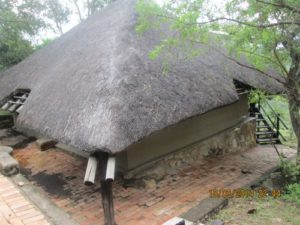
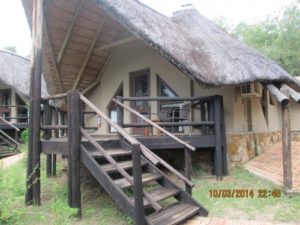
There were 40 units in all …. each reached by brick paths.
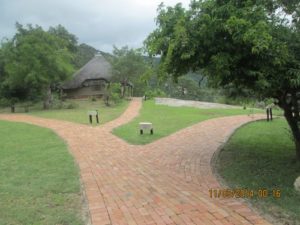
_______________________________________________________________________________________________________
Bongani …. The Overall Environment
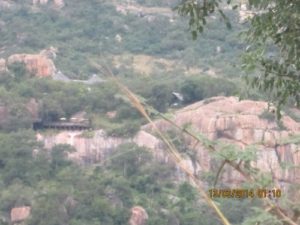
Bongani from a distance
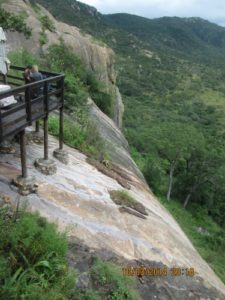
Bongani was on 8,000 hectares of granite country: Bongani Mountain Lodge borders the southern side of the Kruger National Park and offers luxurious bush accommodation situated near the magnificent Malelane Mountains. Humbly located in the 8,000 hectare Mthetomusha Game Reserve, Bongani Lodge welcomes guests to a world of peace and calm. The game reserve in Mpumalanga is home to the “Big Five”, and an entertaining variety of birdlife. The lodge’s location alone inspires travellers from around the world.
This game reserve in Mpumalanga offers the ultimate luxury outdoor living space suitable for families, groups and even individuals. Everyone is invited to indulge in all that is available on offer. During Adventurous game drives and bush walks through the game reserve in Mpumalanga, guests may witness first hand more mammal species than in any other African Game Reserve.
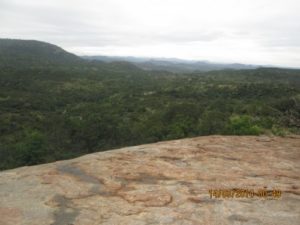
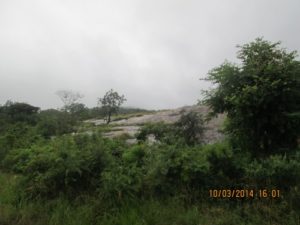


Setting sun on the distant mountains
_______________________________________________________________________________________________________
Four Wheel Driving
Every morning after breakfast, we would go in one of the four wheel drives along the many decomposed granite roads to look at wild animals. There was always a set team of people in each vehicle and each vehicle had it own driver. There would also be another man to the driver who would act as a tracking person. He would sit on little front seat of the vehicle and watch for any traces of animals so that we could see them.
Then about 3.00 pm. in the afternoon, we would go out an another animal observing tour.
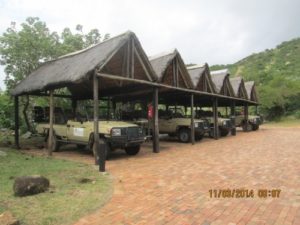
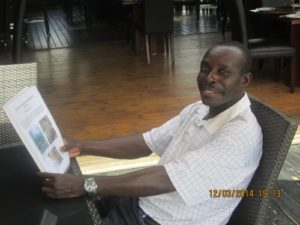
Simeon-our-driver – we got to know him really well. He had been driving for Bongani for twenty years. See what he said and did when the elephant came charging us down below.
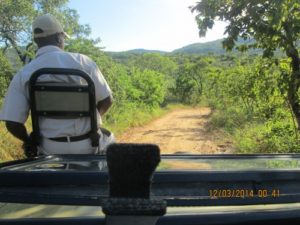
There would also be another man to the driver who would act as a tracking person. He would sit on a little front seat of the vehicle and watch for any traces of animals so that we could see them. He was so good as tracker we were told that he could even tell which cow it was just from the hoof print on the ground. He picked the lion paws print in the mud one morning …. see the photo below.

The main driveway into Bongani
____________________________________________________________________________________
Animals We Saw:
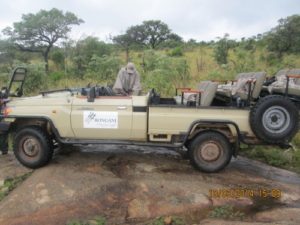
Our four wheel drive parked at the end of a morning for a coffee break
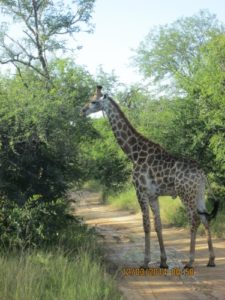
Here was a giraffe in the middle of the road and it would look down to our stopped vehicle as though it were saying: “What you doing here?”
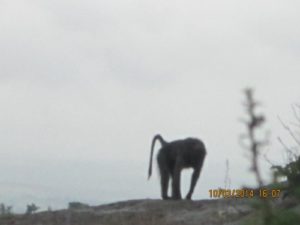
Baboon on a large boulder outcrop
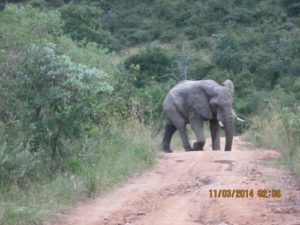
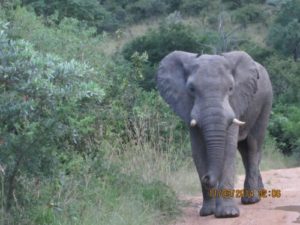
We went out with Simeon our driver on a different decomposed granite road to look for elephants one afternoon. We eventually came out to a slight bushy hill on the left side of the road. We heard some elephants moving among the small trees and bushes. Eventually a female elephant came out and crossed the road with a young elephant following its mother. Was the male elephant to follow? We waited for about five minutes and still nothing.
Simeon backed quietly backed down the road for about 100 metres and we waited some more time for the male elephant to follow. He eventually came on to the road and instead of just crossing to the flattish slope where the female elephant went, he turned and began walking down the road towards us. He came closer and closer and became a very big animal. He looked very fierce with the big tusks and huge legs. Then he really did put fear into us. He began swinging his trunk and tusks and stamping his feet. We had read and seen pictures of elephants bearing down on cars of unsuspecting people and just turning them over with the people inside. Was this going to happen to us?
The elephant came within 20 metres of us when Simeon did a very unusual thing. He shouted at the the elephant … “STOP” and banged his door and said: “GO HOME”. The elephant immediately stopped, turned around and went back to where he had come from.
Elephants have very good memories and this situation had occurred some five years earlier with Simeon and this elephant. The elephant REMEMBERED !
_________________________________________________________________________________________________
NOTES ON AFRICAN ELEPHANTS: African elephants are the largest of Earth’s land mammals. Their enormous ears help them to keep cool in the hot African climate.
African elephants are the largest land animals on Earth. They are slightly larger than their Asian cousins and can be identified by their larger ears that look somewhat like the continent of Africa. (Asian elephants have smaller, rounded ears.)
Elephant ears radiate heat to help keep these large animals cool, but sometimes the African heat is too much. Elephants are fond of water and enjoy showering by sucking water into their trunks and spraying it all over themselves. Afterwards, they often spray their skin with a protective coating of dust.
An elephant’s trunk is actually a long nose used for smelling, breathing, trumpeting, drinking, and also for grabbing things—especially a potential meal. The trunk alone contains about 100,000 different muscles. African elephants have two fingerlike features on the end of their trunk that they can use to grab small items. (Asian elephants have one.)
Both male and female African elephants have tusks they use to dig for food and water and strip bark from trees. Males use the tusks to battle one another, but the ivory has also attracted violence of a far more dangerous sort.
Because ivory is so valuable to some humans, many elephants have been killed for their tusks. This trade is illegal today, but it has not been completely eliminated, and some African elephant populations remain endangered.
Elephants eat roots, grasses, fruit, and bark, and they eat a lot of these things. An adult elephant can consume up to 300 pounds (136 kilograms) of food in a single day.
These hungry animals do not sleep much, and they roam over great distances while foraging for the large quantities of food that they require to sustain their massive bodies.
Female elephants (cows) live in family herds with their young, but adult males (bulls) tend to roam on their own.
Having a baby elephant is a serious commitment. Elephants have a longer pregnancy than any other mammal—almost 22 months. Cows usually give birth to one calf every two to four years. At birth, elephants already weigh some 200 pounds (91 kilograms) and stand about 3 feet (1 meter) tall.
African elephants, unlike their Asian relatives, are not easily domesticated. They range throughout sub-Saharan Africa and the rain forests of central and West Africa. The continent’s northernmost elephants are found in Mali’s Sahel desert. The small, nomadic herd of Mali elephants migrates in a circular route through the desert in search of water.
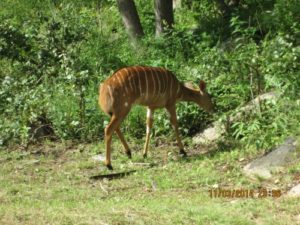
Bushbuck or Kudu = Antelope. These animals are called ‘Bush McDonalds’ …. they multiply so fast !

Lion Paw Prints
We saw a lion on our first day at Bongani but it had rained heavily the previous day and the lion slunk away in the wet grass.
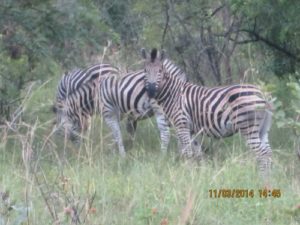
A small herd of zebras
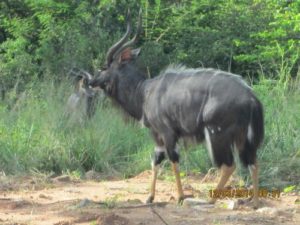
Bushbuck or Kudu = Male Antelope
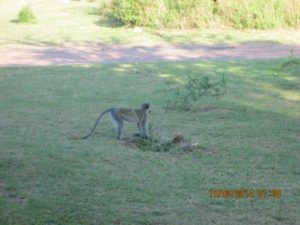
A monkey is out on the open grass. There were dozens of monkeys out the rocky cliff edges. There was a prominent notice to make sure our windows were all closed as monkeys could get in and mess our apartment.
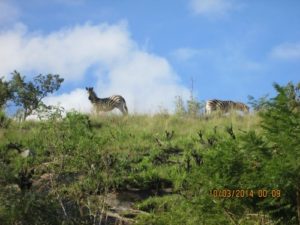
Two Zebras outlined on the hill
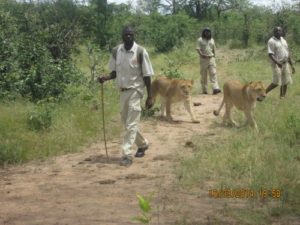
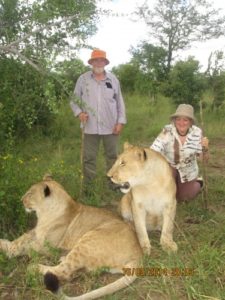
While we were at Bongani, we were all taken to a lion breeding facility. At one time in history lions were the most widespread carnivores on the planet. Even at the turn of the 20th century they could be found across the African continent and countries throughout Asia. By the 1950s the last lions in Asia, outside of a tiny population in India, had become extinct and the African population was reduced to only sub-saharan Africa.
Today only 32,000 lions remain. With 75 percent of their habitat lost due to human development and agriculture, the remaining populations are often geographically isolated from one another, which can lead to inbreeding, and consequently, reduced genetic diversity. Therefore the lion is considered a vulnerable species by the International Union for Conservation of Nature, and the Asiatic subspecies is endangered. At an opportune moment of growth, lions are released into wild areas to help populate total lion numbers.
At the breeding facility, lions are very tame and two lions accompanied us on a short walk with the staff. At an opportune moment, we all had an opportunity to pat a lion and get our photograph taken.
- The African lions’ numbers are diminishing rapidly due to habitat destruction, persecution by livestock farmers outside of protected areas, and human greed.
- Trophy hunting not only depletes the population of the African lion, but threatens its gene pool as well. Killing the dominant male of a pride (normally the target of a trophy hunt) sets off a chain of instinctive behaviour in which the subsequent dominant male kills all the young of the previous male (6-8 estimated deaths result from each male thst is shot).
- In the late 20th century, wildlife preserves were created to restrict safari hunting, but the African lion population continues to decline. Their numbers have declined from 100,000 in the 1980s, halving to 50,000 in 1990, to as few as 16,000 today.
- An ever-expanding human population has led to competition between herders and lions for land and food. Lions living at the edge of the preserves sometimes stray from protected areas in search of easy prey. The Maasai and other ranchers will often kill them to protect their livestock and source of livelihood.
- The retaliatory killing of lions by pastoralists is a serious threat to lion conservation in Maasai Steppe.
- Over the past six years, pastoralist families have lost more than 500 herds of livestock including cattle, goat, sheep and donkeys due to predation by lions, while more than 226 lions have been killed in retaliation for livestock predation.
______________________________________________________________________________
